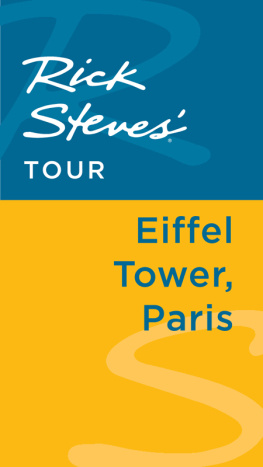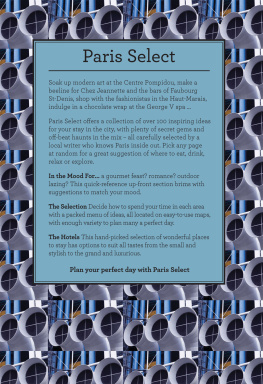E is for Eiffel Tower
A France Alphabet

Written by Helen L. Wilbur and Illustrated by Yan Nascimbene
Pour Christopher
Helen

Pour Chlo
nonno
Author Helen Wilbur wishes to thank and acknowledge her dear friend Hlne Potter for her help in reviewing the manuscript.
Sleeping Bear Press gratefully acknowledges and thanks educator Sheryl Moll for her assistance in preparing the French language glossary.

E is for Eiffel Tower
A France Alphabet
From its achievements in art and architecture (Chartres Cathedral), science and exploration (Louis Pasteur), music and literature (Marcel Proust), the country of France has had a profound impact on the world. E is for Eiffel Tower: A France Alphabet explores its venerable history, artistic genius, and cultural heritage.
Sumptuous artwork magnifies each letter topics poem and expository text.
Artists critics tried to stifle
the daring design of Gustave Eiffel.
Yet a hundred years later, still it stands,
a symbol of France to other lands.
Young readers can experience the treasures of the Louvre Museum, play hide-and-seek in the gardens of Versailles Palace, or get a birds-eye view of Paris from the Eiffel Tower. The achievements of Napolon, Claude Monet, and Victor Hugo come to life alongside stunning monuments, breathtaking scenery, and history-in-the-making moments that have shaped France and influenced the world at large.
From the lavender fields of Provence to the streets of Paris, E is for Eiffel Tower showcases the treasures of France.
A glossary of French words, including phonetic spellings, is provided at the back of the book.
Helen L. Wilbur
A former librarian, Helen Wilbur has run a catering business, acted, taught school, sold cookware, and, for most of her career, worked on the electronic side of the publishing world. She has always had a fascination for French history, cooking, literature, and culture, and visits France frequently. Helen has a BA in English Language and Literature from the University of Chicago and a masters degree from Columbia University in Library Science. Helen also authored M is for Meow: A Cat Alphabet (a 2007 ASPCA Henry Bergh Honor Book for illustration); Z is for Zeus: A Greek Mythology Alphabet (a 2009 Moms Choice Selection); and Lilys Victory Garden for Sleeping Bears Tales of Young Americans series. Helen lives in New York City.
Yan Nascimbene
Half-French and half-Italian, Yan Nascimbene spent his childhood and adolescence between Paris, Turin, and the south of France before moving to the United States where, as an art student, he met Joan, a painter, writer, and ceramist. Yan has drawn over 300 book covers and 50 fully illustrated books, some of which he wrote. His previous childrens books include Yuki and the One Thousand Carriers; Hachiko: The True Story of a Loyal Dog; and Castle of Books.
Widely exhibited in France, Italy, the United States, and Japan, Yan has been awarded the Society of Illustrators Gold Medal and has twice won its Silver Medal. He is a three-time recipient of the Bologna International Book Fair Graphic Award. Yan and Joan have three grown children, Nomie, Amanzio, and Dawn. They live in Provence, in the village of Cotignac.

A
Early cultures of hunters and gatherers lived many thousands of years ago in what is modern-day France. The Lascaux and Chauvet caves contain the earliest known wall paintings of deer, bison, horses, and other animals. Some caves have tracings of human hands made by these early people.
In ancient times the land we know as France was part of a large territory the Romans called Gaul. Celtic tribes inhabited Gaul, living a nomadic and warlike existence. Gallic warriors were known for their fighting spirit. Despite their fierceness in battle, the Gauls were no match for the discipline and organization of the Roman legions. Julius Caesar conquered Gaul for Rome and brought their proud warrior king, Vercingtorix, as a captive to Rome.
For over five centuries Gaul was part of the Roman Empire. The Romans were great builders. They constructed beautiful and lasting structures: aqueducts to carry fresh water, roads to link cities, temples for worship, walls for protection, amphitheaters and arenas for public spectacles, all varieties of public and private buildings.
Traces of many still survive and a few are still in use. You can attend the opera, theater, and musical concerts, including rock concerts, in the magnificent Roman amphitheaters in Arles, Orange, and Nimes.
As the Roman Empire collapsed, marauding tribes challenged Roman control in Gaul. The Franks defeated Rome in AD 486 to establish the kingdom of France. King Clovis united the Frankish tribes, converted to Christianity, and founded the first line of French kings. The last king to rule France was Louis Philippe, whose reign ended in 1848.
A is for Amphitheaters, Aqueducts, and Arles
Long after Caesar conquered Gaul and Franks and Huns caused Rome to fall, the monuments all testify that art and culture never die.

B
France has 26 regions, each with its distinct landscape, culture, cuisine, and charm. In addition to the 22 regions of metropolitan France on the continent of Europe, there are four overseas regions in the Caribbean, South America, and the Indian Ocean. Slightly smaller in area than the state of Texas, France is the biggest country in Western Europe.
Frances land varies from broad, flat plains to the high mountains of the Alps and Pyrnes. France has three main rivers (the Seine, the Loire, and the Rhne), with a network of canals allowing barges to cruise through much of the country. France borders six countries as well as the Mediterranean Sea and the Atlantic Ocean. The Channel Tunnel connects France to England, running underneath the English Channel for 32 miles.
The combination of land and sea creates a dramatic landscape, nowhere more magical than the tiny island of Mont-Saint-Michel off the coast between Brittany and Normandy. The abbey spire of Mont-Saint-Michel rises high over broad tidal flats. Powerful tides rush over ten miles to surround the island.
B is for Brittany and Burgundy
See fishing boats in Brittany, travel to Mont Blanc to ski, go back in time at Chenonceaux, La Belle Francethe place to go.

C
The cathedrals of the Middle Ages took generations, sometimes centuries, to build. Stonecutters, masons, carpenters, glaziers, roofers, and craftsmen of all kinds labored day after day, knowing that their childrens children might not live to see the great church completed. No blueprints or plans have survived to show us how, with simple tools and hand labor, generations of workers managed to construct such magnificent buildings.













